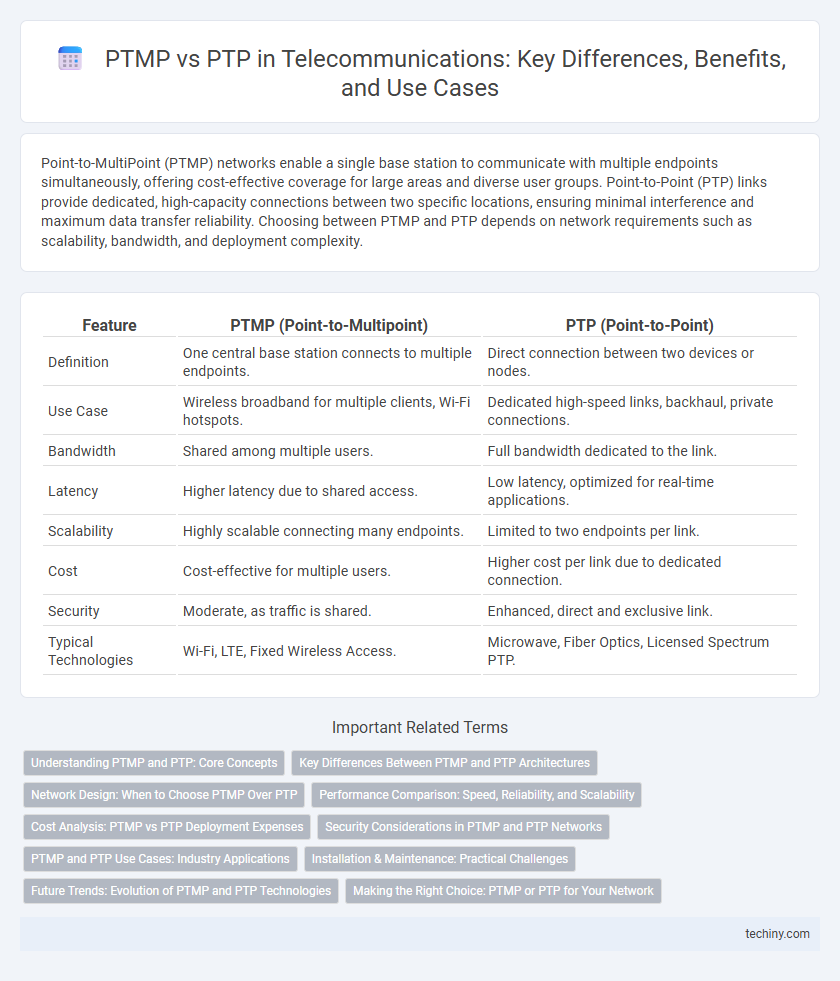Point-to-MultiPoint (PTMP) networks enable a single base station to communicate with multiple endpoints simultaneously, offering cost-effective coverage for large areas and diverse user groups. Point-to-Point (PTP) links provide dedicated, high-capacity connections between two specific locations, ensuring minimal interference and maximum data transfer reliability. Choosing between PTMP and PTP depends on network requirements such as scalability, bandwidth, and deployment complexity.
Table of Comparison
| Feature | PTMP (Point-to-Multipoint) | PTP (Point-to-Point) |
|---|---|---|
| Definition | One central base station connects to multiple endpoints. | Direct connection between two devices or nodes. |
| Use Case | Wireless broadband for multiple clients, Wi-Fi hotspots. | Dedicated high-speed links, backhaul, private connections. |
| Bandwidth | Shared among multiple users. | Full bandwidth dedicated to the link. |
| Latency | Higher latency due to shared access. | Low latency, optimized for real-time applications. |
| Scalability | Highly scalable connecting many endpoints. | Limited to two endpoints per link. |
| Cost | Cost-effective for multiple users. | Higher cost per link due to dedicated connection. |
| Security | Moderate, as traffic is shared. | Enhanced, direct and exclusive link. |
| Typical Technologies | Wi-Fi, LTE, Fixed Wireless Access. | Microwave, Fiber Optics, Licensed Spectrum PTP. |
Understanding PTMP and PTP: Core Concepts
Point-to-Multipoint (PTMP) and Point-to-Point (PTP) are fundamental wireless communication architectures used in telecommunications for different network topologies. PTMP involves a single central transmitter communicating with multiple receivers, optimizing bandwidth distribution for scenarios like broadband internet access in densely populated areas. PTP establishes a direct, dedicated link between two endpoints, ensuring high-speed, low-latency connectivity essential for critical applications such as enterprise networks and backhaul connections.
Key Differences Between PTMP and PTP Architectures
PTMP (Point-to-Multipoint) architecture connects multiple endpoints to a single central node, optimizing bandwidth distribution for broad area coverage in telecommunications networks. PTP (Point-to-Point) architecture features a dedicated link between two nodes, ensuring higher data transfer rates, reduced latency, and enhanced security for critical communication channels. PTMP is ideal for scalable residential or enterprise access, while PTP suits high-performance backhaul and private network applications.
Network Design: When to Choose PTMP Over PTP
Point-to-Multipoint (PTMP) network design is ideal for scenarios requiring cost-effective coverage of multiple endpoints over a broad area, such as rural broadband deployment or urban Wi-Fi access. PTMP reduces infrastructure complexity by using a single hub to communicate with multiple subscriber units, facilitating scalable and efficient bandwidth distribution. Point-to-Point (PTP) setups are preferred for high-capacity, low-latency links where dedicated, secure connections between two fixed locations are critical.
Performance Comparison: Speed, Reliability, and Scalability
Point-to-Point (PTP) links typically offer higher speed and lower latency due to a dedicated connection between two endpoints, enhancing reliability by minimizing interference and signal degradation. Point-to-Multipoint (PTMP) systems provide greater scalability by serving multiple clients from a single base station, but this can lead to reduced speed per user and potential reliability issues caused by shared bandwidth and environmental factors. In telecommunications, selecting between PTMP and PTP hinges on balancing the need for maximum throughput and stable connections with the demand for network expansion and efficient resource allocation.
Cost Analysis: PTMP vs PTP Deployment Expenses
PTMP (Point-to-Multipoint) deployments generally incur lower initial costs compared to PTP (Point-to-Point) setups due to shared infrastructure and reduced equipment requirements. PTP networks demand higher expenses for dedicated hardware and precise line-of-sight alignment, increasing installation and maintenance budgets. Evaluating long-term operational costs reveals PTMP as more cost-efficient for broad coverage, while PTP suits high-capacity, low-latency connections despite higher investment.
Security Considerations in PTMP and PTP Networks
PTMP (Point-to-Multipoint) networks often face higher security risks due to multiple endpoints sharing a single communication channel, increasing vulnerability to interception and unauthorized access. PTP (Point-to-Point) connections provide enhanced security by establishing dedicated links between two devices, minimizing exposure to external threats and simplifying encryption protocols. Implementing robust encryption standards like AES-256 and secure authentication mechanisms is crucial in both PTMP and PTP networks to safeguard data integrity and prevent cyberattacks.
PTMP and PTP Use Cases: Industry Applications
Point-to-Multipoint (PTMP) networks excel in providing broadband connectivity to multiple users in industries like agriculture for precision farming, smart cities for IoT device integration, and public safety for emergency communication systems. Point-to-Point (PTP) links offer high-capacity, low-latency connections ideal for backhaul in telecommunications, connecting remote cellular towers, and supporting enterprise data center interconnects. Both PTMP and PTP serve critical roles in expanding network reach and enhancing communication efficiency across diverse industrial applications.
Installation & Maintenance: Practical Challenges
PTMP (Point-to-Multipoint) installations typically face challenges with signal interference and require precise alignment of multiple subscriber units, complicating maintenance due to varied connection points. PTP (Point-to-Point) systems benefit from straightforward alignment and less interference, but any misalignment can lead to significant downtime and costly repairs. Routine inspections and specialized equipment for both PTMP and PTP are essential to ensure optimal performance and minimize service disruptions.
Future Trends: Evolution of PTMP and PTP Technologies
PTMP and PTP technologies are evolving rapidly with advancements in 5G and IoT network demands, driving higher capacity and lower latency solutions. Emerging full-duplex systems and millimeter-wave frequencies enhance PTMP scalability, while PTP links are gaining precision timing and increased bandwidth for ultra-reliable low-latency communication (URLLC). Integration of AI-driven network optimization further improves dynamic resource allocation and interference management in both PTMP and PTP deployments.
Making the Right Choice: PTMP or PTP for Your Network
Choosing between PTMP (Point-to-Multipoint) and PTP (Point-to-Point) wireless communication depends on network requirements such as coverage area, bandwidth needs, and cost efficiency. PTMP systems provide a centralized wireless connection to multiple endpoints, optimizing resource allocation for widespread, lower-data-demand networks, while PTP links deliver dedicated, high-bandwidth connections ideal for backhaul and critical data transmission. Selecting the right technology requires analyzing network topology, user density, and traffic priorities to ensure optimal performance and scalability.
PTMP vs PTP Infographic

 techiny.com
techiny.com